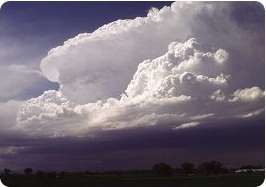Physics and Dynamics of the Global Atmosphere
Mteor 341: Atmospheric Physics I introduced the concepts and laws of thermodynamics, the
thermodynamics of water vapor and heteorogeneous systems, mixtures of gases, moist air, and
hydrostatic equilibrium and stability.
Mteor 342: Atmospheric Physics II covered cloud physics, atmospheric radiation, and
radar meteorology. Topics included droplet and snowflake formation and growth; liquid and frozen
precipitation; the mechanics of radar and reflectivity equations; and atmospheric radiation budget and laws.
Mteor 443: Dynamic Meteorology I taught in detail conservation laws, the governing equations,
circulation, vorticity, and the development of the quasi-geostrophic theory.
Mteor 454: Dynamic Meteorology II continued from MT443 with discussions of the planetary boundary
layer, large- and small-scale wave motions in the atmosphere, atmospheric instability, and the generation of
atmospheric disturbances or perturbations. My project group and I tracked the motion of atmospheric waves at
500hPa and zonal wind speed at two levels in the atmosphere throughout the semester. Near the end of the
semester, we compiled our results and compared them to barotropic Rossby wave theory. Our abstract can be
viewed here, and the final written report is available for
download here.
Return to top of page.
Application of New Weather Technologies
Experience with Gibson Ridge radar software, used to view radar
displays and analyze current radar data.
Experience with the CSU-CHILL S-band,
dual-polarization weather radar located near Greeley, Colorado. I learned to use the CSU-CHILL radar
during my CSU-CHILL Radar REU during the summer of 2011.
Experience with GEMPAK/N-AWIPS, useful in
forecasting and analysis of meteorological data.
Return to top of page.
Weather Observing and Analysis
CSU CHILL Radar REU, Colorado State University and CHILL Radar Facility, Summer 2011
I am researching the application of cloud photogrammetry combined with dual-polarization Doppler
radar measurements to analyze internal cloud processes. After this summer I will continue a part of
this project as my senior thesis in Fall 2011. For more information on this project, please see my
research section.
Student Summer Research Program, Hobart & William Smith Colleges, Summer 2010
I compiled a climatology of lake-effect precipitation over small lakes in the Lake Tahoe, CA/NV, region of the United
States. This project will be continued for my Honors thesis in Spring 2012. For more information on this project,
please see my research section.
Return to top of page.
Advanced Mathematical Tools
Proficiency in working with IBM SPSS Statistics software,
a highly flexible and user-friendly program with excellent statistical capabilities. Experience gained during
Hobart & William Smith Colleges Summer Research Program, summer 2010.
Familiarity with JMP statistical software, another useful statistical analysis
program. Experience gained during Stat 105, Iowa State University, fall 2009.
Return to top of page.
Computer Programming and Modeling
Meteorology 227: Computational Meteorology is an introduction to computer programming in FORTRAN 90,
with a focus on meteorlogical applications. The class emphasized the basics of efficient programming
techniques and style. We did this with thorough practice in top-down design, as well as writing, running,
and debugging multiple programs. Topics covered in the class include selective and repetitive execution,
arrays, input/output, file processing, operations and functions, and subprograms.
Return to top of page.
Effective Oral and Written Communication
English 250H: Written Oral, Visual, and Electronic (WOVE) Composition focused on in-depth analysis,
composition, and reflection on WOVE documents and discourse in academic, civic, and cultural contexts.
The course emphasized argumentation which included developing claims, generating reasons, and supplying
and proving evidence. Please click here to view my Engl 250H
portfolio.
Sp Cm 212: Fundamentals of Public Speaking taught the theory and practice of basic speech
communication principles and applied that theory to public speaking. We gave multiple speeches
throughout the semester, both prepared and impromptu.
- Click here to view an outline from my Informational Speech.
- Click here to view the accompanying PowerPoint presentation.
English 314: Technical Communication is a class that emphasizes theories, principles, and
practices of effective written communication with respect to technical information. The class attends
to major strategies for analyzing and adapting to audiences in various situations, and organizing the
document to best fit the audience at hand. We have extensive practice in technical writing, including proposals,
reports, technical descriptions, instructions and procedures, and individual and team presentations.
- Click here to view my Technical Instructions and Technical Description.
- Click here to view my team's proposal and
here to view our final report.
History 429: "Montrous London" - History of London 1500-1800 was a class that fulfilled an Arts and
Humanities requirement for Iowa State. The class was a study of the "social, economic, cultural,
political, and environmental history" of early modern London (from Iowa State website) through the
examination of primary and secondary sources as well as a research-intensive term paper. In addition, over
spring break the class travelled to London for ten days to experience the culture and history of London
firsthand. While in London my class attended lectures by renowned London historians. We also were able
to examine primary sources, such as court records and diaries from the time period, available in the
London Metropolitan Archives, the largest local authority archive in the UK. Please click
here to view my term paper.
Return to top of page.
